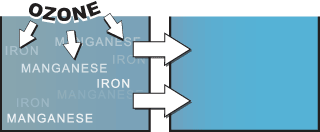Wednesday, April 24, 2024, 5:02 PM
Site: Pa. DEP Operator eLearning Center
Course: Pa. DEP Operator eLearning Center (PADEP)
Glossary: Course Glossary
O
O&M O&M – Operation and Maintenance
- (PNR01) Public Notification – An Introduction for NCWSs (2332)
|
|
OCCT Optimal Corrosion Control Treatment - Corrosion control treatment that minimizes the lead and copper concentrations at users' taps while ensuring that the treatment does not cause the system to violate any primary maximum contaminant level.
- (LCR10) Lead and Copper Rule – Basics (1423)
- (LCR11) LCR – Initial Planning, Monitoring and Reporting (1488)
|
|
One full year any 12-consecutive month period of monitoring.
- (DBP30) DBP Rule – Monitoring and Reporting Requirements for PWSs Using Ozone (1279)
|
|
Optimal Corrosion Control Treatment Optimal Corrosion Control Treatment (OCCT)
Corrosion control treatment that minimizes the lead and copper concentrations at users' taps while ensuring that the treatment does not cause the system to violate any primary maximum contaminant level.
- (LCR10) Lead and Copper Rule – Basics (1423)
- (LCR11) LCR – Initial Planning, Monitoring and Reporting (1488)
|
|
Organic
- Relating or belonging to the class of chemical compounds having a carbon basis.
- (BNR01) Nitrification and Denitrification – An Introduction to Nitrogen Removal (1485)
- (BNR02) Nitrification Factors – Suspended Growth Treatment Systems (1821)
- Substances that come from animal or plant sources and contain carbon. Examples include wood, sugars, proteins, plastics, petroleum-based compounds, solvents and pesticides.
- (BIO01) Biosolids Agronomic Loading Rates Part 1 (1247)
- (BIO02) Biosolids Agronomic Loading Rates Part 2 – Manure (1484)
|
|
Organic Contaminants Derived from animals and plants, or may be manufactured chemical compounds. However, all organics contain carbon. Organic contaminants can be biodegradable, which means that the contaminants can be consumed by bacteria and other microorganisms. In the process of being consumed, these organics will exert an oxygen demand (BOD) which can be measured as the Biochemical Oxygen Demand (BOD) of the wastewater. Some organic contaminants (refractory organics) are resistant to biodegradation.
- (BIO10) Estimating Sludge Volume (2343)
|
|
Organic Material
- Relating or belonging to the class of chemical compounds having a carbon basis.
- (BNR01) Nitrification and Denitrification – An Introduction to Nitrogen Removal (1485)
- Material which comes mainly from animal or plant sources. Organic wastes generally can be consumed by bacteria and other small organisms.
- (BIO10) Estimating Sludge Volume (2343)
|
|
Organic Substances Substances that come from animal or plant sources and contain carbon. Examples include wood, sugars, proteins, plastics, petroleum-based compounds, solvents and pesticides.
- (DBP02) DBP Rule Monitoring and Reporting – Job Aids (1283)
- (DBP10) DBP Rule Monitoring and Reporting for Chlorine⁄Chloramines (1284)
- (DBP13) DBP Rule Monitoring and Reporting for TTHM⁄HAA5 (1285)
|
|
Organic Waste Waste material that comes mainly from animal or plant sources. Organic wastes generally can be consumed by bacteria and other small organisms. Inorganic wastes are chemical substances of mineral origin.
- (BNR01) Nitrification and Denitrification – An Introduction to Nitrogen Removal (1485)
- (BNR02) Nitrification Factors – Suspended Growth Treatment Systems (1821)
|
|
Oxidant
- A substance that readily adds (takes on) electrons.
- (DBP01) DBP Rule – Overview (1282)
- A substance that is used as an oxidizing agent, which causes a substance to lose electrons, changing its chemical nature.
|
|
Oxidation The addition of oxygen, removal of hydrogen, or the removal of electrons from an element of compound. With respect to water treatment, organic matter is oxidized to more stable substances.
- (BNR01) Nitrification and Denitrification – An Introduction to Nitrogen Removal (1485)
- (BIO10) Estimating Sludge Volume (2343)
|
|
Ozonation The application of ozone to water for disinfection or for taste and odor control.

|
|
